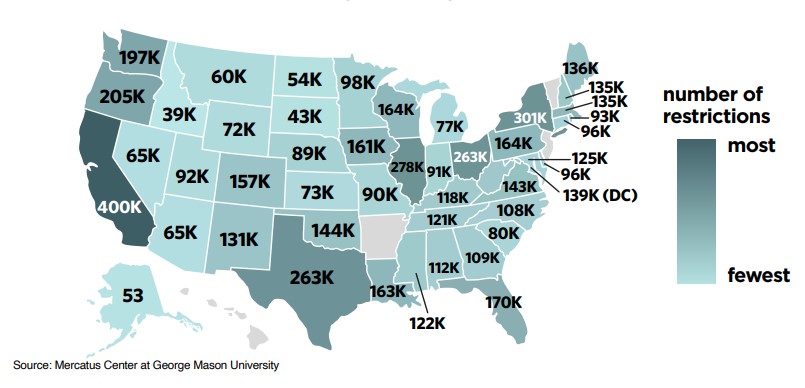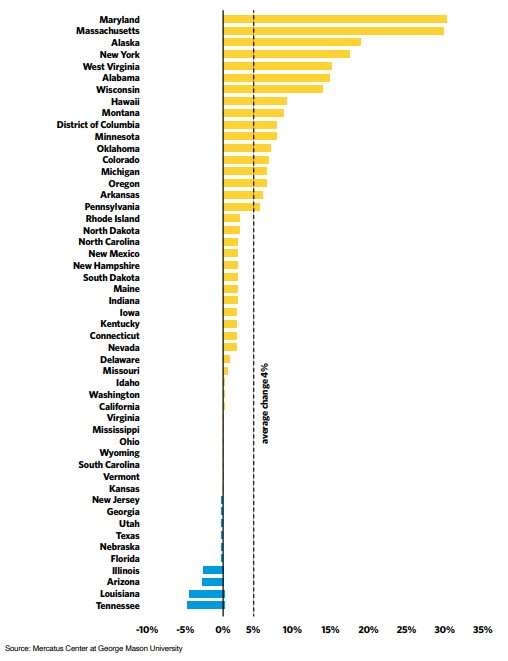Policies to slow and shrink our state’s regulatory burden
A state government has two categories of economic policy levers available to it: the first is fiscal policy, taxes and spending, and the second is regulatory policy.
Burdens of regulation
Like taxes, regulations impose economic burdens. The state of Minnesota, for example, requires anyone applying for a cosmetology license to complete 1,550 hours of education, write three exams, and pay $285 in fees. While presented as being in the consumer interest, research finds that the only people who benefit from these regulations are those with licenses. Both customers and potential cosmetologists suffer, and economic welfare is reduced, overall.
Regulations also impose political burdens. They give effective legislative power to unelected officials, making the government less responsive to the voters.
Quantifying the burden
Unlike the burden of taxes, however, the burdens imposed by regulations are hard to quantify. Researchers at the Mercatus Center at George Mason University have created State RegData, which quantifies regulations in state administrative codes by looking at how often the terms shall, must, may not, prohibited, and required appear in state laws. While this method is open to criticism, it is the best there currently is. As Figure 1 shows, on this measure Minnesota’s regulatory burden is not relatively high. In 2021, our state, with 98,000 regulations, ranked 28th out of the 46 states and the District of Columbia for which there are estimates. This is partly because of Minnesota’s “formal” rulemaking process, which is a model for other states.
Figure 1: State-Level Regulatory Restrictions, 2021

There is evidence of a concerning trend, however. In 2018, researchers at the Mercatus Center estimated the change in occupation licensing requirements across all 50 states and the District of Columbia between 2012 and 2017 and found that Minnesota had the 11th largest overall increase, as shown in Figure 2.
Figure 2: Change in Breadth and Burden of Licensure by State, 2012-2017

Restraining and reducing the burden
Given the economic and political burdens imposed by regulations, Minnesota’s legislators need to enact laws which will restrain further growth of this burden and, ideally, reduce it from its current level. As we note in our new Policy Briefing ‘Counteracting Regulatory Burdens Options for restraining and reducing state regulatory growth‘, researchers at the Mercatus Center offer eight suggestions. The most promising are:
1) Enact a Pay-as-You-Go Provision Whereby New Regulatory Requirements or Costs Must Be Offset by Eliminating Old Ones
Under a pay-as-you-go (PAYGO) system, the addition of a new regulation would have to be offset by the removal of at least one existing regulation. There is scope for variation. Texas has a system whereby the costs of existing regulations must be eliminated when regulations imposing new costs are added and Ohio passed legislation requiring that two regulatory restrictions be eliminated for each new one added.
2) Adopt Sunset Provisions for State Regulations
A sunset provision is an expiration date built into regulations whereby they automatically expire after a certain amount of time has elapsed. For a regulation to continue, it must be reissued or reauthorized in some way. It is important to consider who should have the power to reauthorize rules (usually the regulating agency or the legislature) and what criteria should be evaluated when reviewing regulations.
Conclusion
Regulations impose both economic and political burdens and do so for no overall benefit. While their impact is hard to quantify and Minnesota seems better situated than some other states, there are indications that our regulatory burden is growing in some key areas. State legislators should act to restrain the further growth of the regulatory burden and, ideally, shrink it.